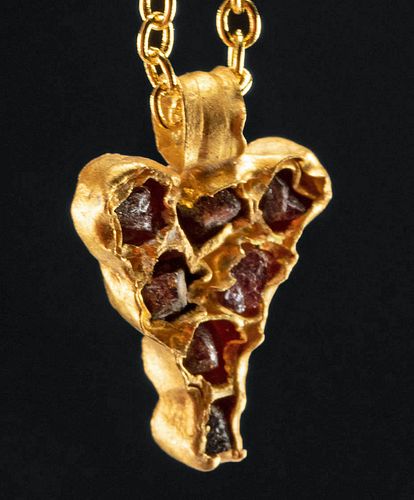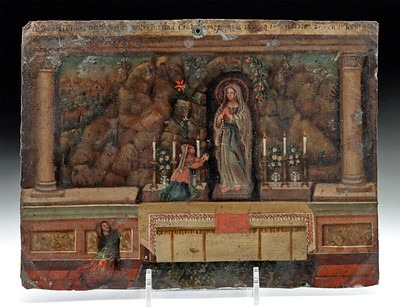Roman Gold Pendant w/ Garnet Clusters
Lot 24a
About Seller
Artemis Fine Arts
686 S Taylor Ave, Ste 106
Louisville, CO 80027
United States
Selling antiquities, ancient and ethnographic art online since 1993, Artemis Gallery specializes in Classical Antiquities (Egyptian, Greek, Roman, Near Eastern), Asian, Pre-Columbian, African / Tribal / Oceanographic art. Our extensive inventory includes pottery, stone, metal, wood, glass and textil...Read more
Categories
Estimate:
$1,800 - $2,500
Absentee vs Live bid
Two ways to bid:
- Leave a max absentee bid and the platform will bid on your behalf up to your maximum bid during the live auction.
- Bid live during the auction and your bids will be submitted real-time to the auctioneer.
Bid Increments
| Price | Bid Increment |
|---|---|
| $0 | $25 |
| $300 | $50 |
| $1,000 | $100 |
| $2,000 | $250 |
| $5,000 | $500 |
| $10,000 | $1,000 |
| $20,000 | $2,500 |
| $50,000 | $5,000 |
| $100,000 | $10,000 |
| $200,000 | $20,000 |
About Auction
By Artemis Fine Arts
Jun 15, 2023
Set Reminder
2023-06-15 10:00:00
2023-06-15 10:00:00
America/New_York
Bidsquare
Bidsquare : VARIETY Ancient, Ethno, Native American, Fine Art
https://www.bidsquare.com/auctions/artemis-gallery/variety-ancient-ethno-native-american-fine-art-12990
Antiquities, ethnographic, native american and fine art from cultures encompassing the globe. Artemis Fine Arts info@artemisgallery.com
Antiquities, ethnographic, native american and fine art from cultures encompassing the globe. Artemis Fine Arts info@artemisgallery.com
- Lot Description
Roman, late Imperial to early Byzantine period, ca. 4th to 6th century CE. A gorgeous example of ancient oenophilia! A pendant in the form of a cluster of grapes, comprised of 7 rough-cut garnets and high-quality - over 22 karat - gold foil, strung to a modern, gold-plated chain to be wearable. The ancient Romans were the first civilization to cultivate grape vines, which were associated with Bacchus (identified in ancient Greece as Dionysos or Dionysus) - the Olympian god of wine, pleasure, ritual madness, ecstasy, and theatre. The cult of Bacchus was hugely popular, signifying the freedom created by wine, music, and ecstatic dance. As the empire was converted to Christianity, grapes and wine continued in popularity and began to symbolize the sacrament of the Eucharist, thus representing rebirth and regeneration. Either way, the Romans knew the power of partying! Size of pendant: 0.6" L x 0.5" W (1.5 cm x 1.3 cm); of largest garnet: 0.13" W (0.3 cm); of strand: 18.5" L (47 cm); gold quality: 95.5% (equivalent to over 22 karats); weight: 1.2 grams
Provenance: East Coast collection, New York Gallery, New York City, New York, USA, acquired before 2010
All items legal to buy/sell under U.S. Statute covering cultural patrimony Code 2600, CHAPTER 14, and are guaranteed to be as described or your money back.
A Certificate of Authenticity will accompany all winning bids.
We ship worldwide and handle all shipping in-house for your convenience.
#178218Ancient pendant strung on modern, gold-plated strand to be wearable. Some bending to gold foil but form is still clear. Otherwise, intact, excellent, and wearable.Condition
- Shipping Info
-
All shipping is handled in-house for your convenience. Your invoice from Artemis Gallery will include shipping calculation instructions. If in doubt, please inquire BEFORE bidding for estimated shipping costs for individual items.
-
- Buyer's Premium



 EUR
EUR CAD
CAD AUD
AUD GBP
GBP MXN
MXN HKD
HKD CNY
CNY MYR
MYR SEK
SEK SGD
SGD CHF
CHF THB
THB













